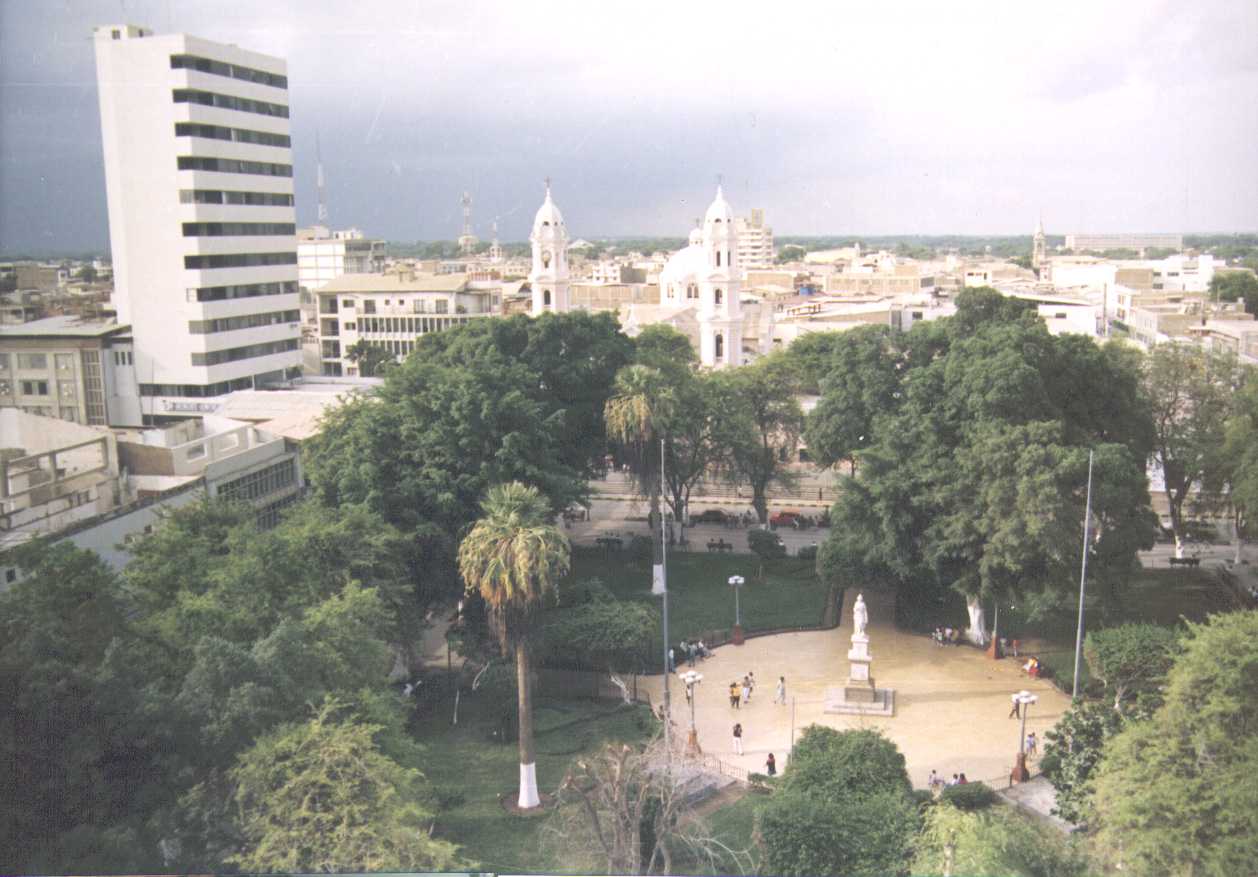
Etimologia | Historia | Situacion | Tallanes |
The state of Piura is located in the Northwest of Peru. between 4º 5' S - 6º 22' S, and 79º00' W - 81º7' W. It has borders with the state of Tumbes and the Republic of Ecuador to the North, the state of Lambayeque to the South, the state of Cajamarca to the East, and the Pacific Ocean to the West.
The capital city of Piura is located at an altitude of 25 m above sea level. The seaside provinces do not surpass 100 m altitude, and the highland cities of Ayabaca and Huancabamba reach 2715 and 1971 m respectively. In the coast, the average temperature is 35ºC in the summer and 16ºC in the winter. Rainfall is low and the rainy season extends from January to April.
The tallanes and yungas were the first dwellers of the state of Piura. They came from the highlands and, during an uncertain period of time, lived in behetrias (populations with neither organization nor a unique leader). Thereafter, they were subjugated by the mochicas and, centuries later, by the Inca Yupanqui, about 40 years before the arrival of the Spain.
Francisco Pizarro arrived in 1532 and founded the first Spanish city in South America; he named it San Miguel and it was located in the region of Tangararas. The exact date of the foundation is still a source of controversy, but, for the celebrations of the 450 years of the first foundation, the 15 of July was adopted as the official date. During the colony, life was peaceful and calm until the incursions of Almirants Brown and Cochrane, from the liberation expedition of San Marton, ignited the wish for freedom. The 4 of January of 1821, the people proclaimed independence at the atrium of the Church of San Francisco. Likewise, the 1000-man division of Piura contributed victoriously to the independence of Ecuador, where they fought in the Battle of Pichincha. In 1532, the city was moved to the Monte de los Padres (Chulucanas), which today is the harbor of Paita. But, owing to the attacks of pirates and corsairs, Don Juan de Caldazo finally founded today's city of Piura naming it San Miguel del Villar del Transito de Piura. The 4 of January of 1821, the independence of Piura was proclaimed.
o tambien... (lo que sigue forma la parte de "Agradecimientos" en mi tesis doctoral, que es la unica seccion de una tesis en la que esta permitida una cierta libertad literaria, por ello este apartado solo guarda un lejano parecido con la realidad)
La cultura Vicus, contemporanea al apogeo de los incas, se asentaba en
la zona denominada Chulucanas, al norte del Peru, en lo que es hoy la
provincia de Piura y en aquel entonces el Alto Pirua, una zona boscosa
de algarrobos y altos zapotes cruzada por el rio Chipillico. Los vicus
eran expertos cazadores y buenos agricultores y en los dias claros podian
divisar el mar desde el cerro de la cabeza de serpiente a traves del desierto,
a casi 100 kil¢metros de distancia. Su vida cotidiana nos ha sido legada
en su excelente alfareria en la que representaban con inusual detalle los
acontecimientos mas nimios. Pero..., nunca habian llegado al mar. No lo habian hecho porque en la zona baja del valle, en realidad en el
borde del valle donde este se va transformando poco a poco en el terrible
desierto de Sechura, se asentaban los Tallanes. Esta era una sociedad
matriarcal, de indios fuertes, de piel curtida y salina que podia
facilmente adentrarse en el desierto hasta alcanzar el mar de Bayovar
en el que se mostraban exquisitamente habilidosos con sus caballitos
de totora. Vivian basicamente de la pesca y su alfareria era simple
y practica, como sigue siendo la que se elabora en Simbila. Cuando los incas llegaron desde el sur, desde el este y desde el
norte poco podian hacer estos dos pueblos pequen~os para enfrentarse
al coloso. Pero lo hicieron. Cuenta la leyenda que en lo que hoy es
el Monte De Los Curas y en aquel tiempo PaloParado una noche fresca
se reunieron, el nictalope pabur (el que ve en la noche), y la sinchi
atarama (la que todo lo puede), y bailaron con sus mejores trajes, y
bebieron del agua clara de las lagunas de las huaringas, discutieron
que podian hacer, y al final aconsejados por sus mejores hechiceros
decidieron que debian trabajar juntos, y a esto llamaron la minga.
Por ella, los amautas (los que todo lo saben) de cada pueblo, ensen~arian
a un grupo selecto de supays (los que estan dispuestos a saberlo) de cada
bando sus habilidades, de esta forma, pensaron, sus conocimientos
perdurarian en el tiempo, y con el paso de el serian invencibles.
Los incas les vencieron militarmente, pero nunca les conquistaron
y esta uni¢n de conocimientos aun sigue en pie para estas culturas,
y quiza eso explique por que algunas ceramicas vicus representan caballitos
de totora aun cuando nunca habian llegado al mar y c¢mo la ceramica
tallan tan simple y practica sigue vigente a traves de los siglos. ... a los que enseñaron, a los que aprendieron y a los que hicieron el esfuerzo de trabajar juntos.